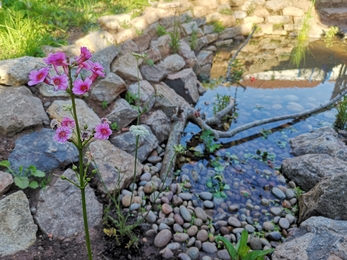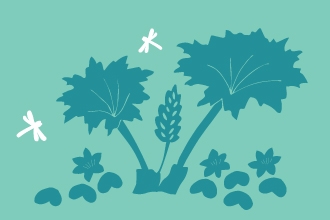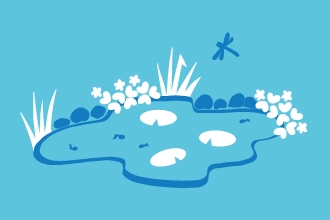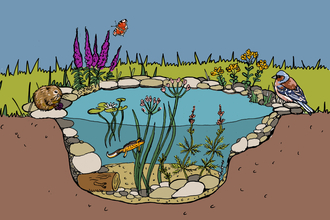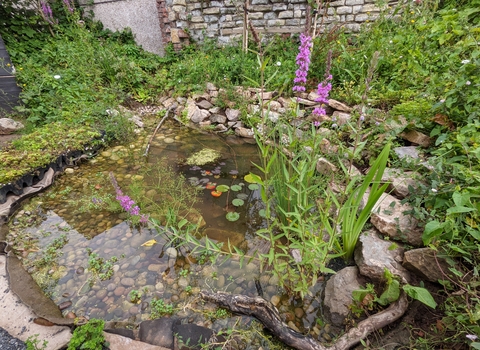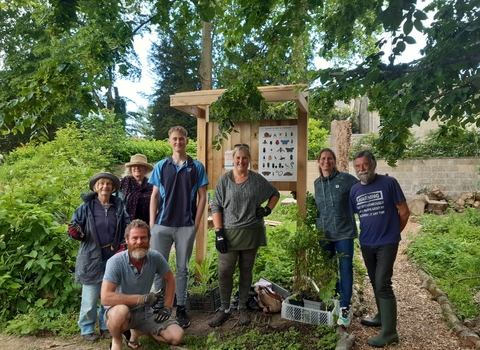
Team Wilder Bog Gardens
Bog gardens are important to wildlife
Written by Oliver Hall, Avon Wildlife Trust volunteer
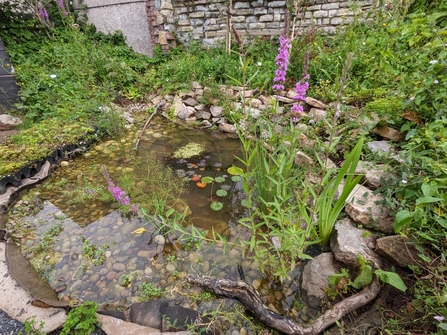
#pondgoals
There are many good reasons for creating a bog garden, starting with the fact that they can be visually stunning and abuzz with nature, from frogs and toads to dragonflies and damselflies.
What is a bog garden? The edge of a pond or a naturally waterlogged area, which can be in your garden or in the community. They can naturally occur or can be created or enhanced.
If you already have a waterlogged area but found some plants you’ve bought struggle to grow there – then it’s time to embrace the damp. Soggy ground conditions are enjoyed by a wide variety of native British plants, almost all of which are attractive to widening the number and variety of wildlife attracted by and benefitting from your garden.
Many of these plants have long blooming times, so by combining just a few will enable your garden to keep supplying pollen and nectar from early spring well into autumn. If you have a pond, a bog garden also provides an important stepping stone area to provide a transition to the surrounding dry land for many animal and plant species.
Creating a bog garden for wildlife
Even if your garden does not naturally revert to a mini-marshland, you can create one from scratch:
- Ideally choose an area that is not overhung by large trees, as most of the plants that enjoy having permanently damp feet also like plenty of sun – as do their insect visitors.
- Mark out the area and dig to a depth of 30cm, lay a butyl rubber pond liner but unlike with a pond, make a few slits or holes with a garden fork to allow water to slowly drain away in the manner of natural bog conditions.
- Adding some old logs and rocks can act as areas for small animals to perch, bask or hide – and if you’re going to need to walk through your bog garden you will need to lay some stepping stones or a boardwalk, which may also provide the same function for wildlife.
- Refill the area with the soil and water thoroughly, with rainwater if possible, then leave for a week before doing any planting to let the area settle.
- Water your bog during dry conditions, using rainwater or ‘grey’ water from your house if you can and respecting any hosepipe bans.
It is also possible to make the edges of an existing pond into a bog garden.
HOW TO: create a bog garden from scratch.
If space is more limited, you can even create a mini bog garden using a container and the same principles as above, with a few small holes for drainage.
HOW TO: create a mini pond
Plant ideas for a bog garden
There are many plants that thrive in damp or waterlogged soil, many you can buy from Grow Wilder, supporting nature in your garden as well as funding for Avon Wildlife Trust. Many are colourful and dramatic, with some growing tall or spreading quickly, but most importantly for wildlife, you are buying plants that attract insects, including bees, butterflies and those that will be eaten by birds and dragonflies.
Check also whether the plants you’re buying prefer sun or partial shade, how much damp and space they require – more versatile ones could tie the area in with the surrounding dryer ground. Planting a combination of short and tall plants provides good cover and perches.
Some ideal plants to start a bog garden, offering a range of flowering seasons might include:

Richard Burkmar
Marsh marigold (pictured) also known as Kingcup flowers in spring, with the spectacular yellow blooms providing early nectar for butterflies and bees, as well as providing shelter for frogs and other creatures.
Cuckooflower is another early-flowering options that enjoys the damp.
While ragged robin is increasingly rare in the wild, they thrive in a bog garden with pink flowers that are beloved by bumblebees, butterflies and honey bees between May and August.
Hemp-agrimony comes into its own later in the summer and autumn, with its tiny pink blooms very attractive to all kinds of insects, including butterflies like the Small Tortoiseshell and Red Admiral.
Water figwort’s maroon flowers arrive around midsummer and keep providing nectar for bees through to September.
Devil’s-bit scabious (pictured below) blooms between July and October, with its purple-blue flowers attracting a wide variety of bees and insects, including the declining Marsh fritillary butterfly.

Amy Lewis
Meadowsweet’s tall white blooms are the food plant for the larvae of several moth species and a many types of insect.
A much wider array of bog garden plants is available from Grow Wilder in Bristol, including: Brooklime, Corky-fruited Water-dropwort, Common Valerian, Devil’s Bit Scabious, Gypsywort, Marsh Woundwort, Meadowsweet, Ragged Robin, Sneezewort, Skullcap, Square-Stem St John’s Wort, Water Mint, Wild Angelica and Yellow Loosestrife.
Others you might try include: Creeping Jenny, Dogwood, many native British ferns (lady Fern, Royal Fern, Marsh Fern), Meadowsweet, Purple Loosestrife, Water Avens and Water Forget-me-not.
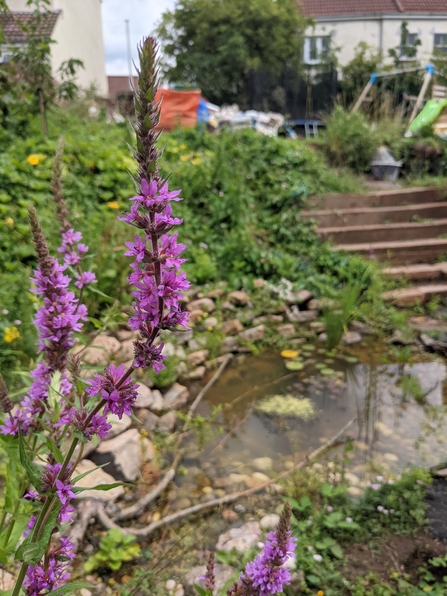
Pond Tom Wilmott
Tom in BS3 has an amazing pond with a bog garden section allowing wildlife to easily get in and out of the pond. He has successfully added water mint, watercress and many more bog plants from Grow Wilder.
Next steps for your bog garden
Once your bog garden is planted – enjoy the stunning plants and watch the wildlife arrive. Also, you could tell us about it as part of Team Wilder, like Tom from Bristol BS3.
Creating a bog garden is one of various changes to your everyday life that can make a huge difference to you and local wildlife. One of the core ideas of Team Wilder is that because the total area of Britain’s gardens is greater than the total size of nature reserves, as more of us make changes to our gardens, patios and window boxes, the combined change we are making is huge.
Many of us are actively making a difference already, by sharing space with wildlife or championing wildlife-friendly practices. To tip the balance, we need many more people on nature’s side. And those that share their experiences can inspire others.
Resources

(C) Hannah Bunn
Be part of Team Wilder
All actions for nature collectively add up and creates life for people and wildlife.
Share your actions for nature, like Tom by sharing and tagging @avonwt on social media and
Log your actions for nature on the map



